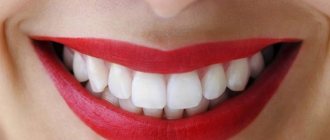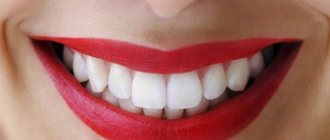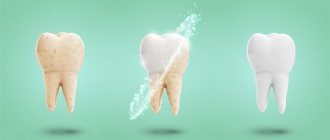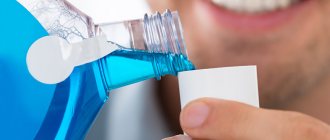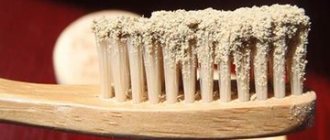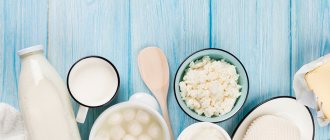1479
The desire to have a beautiful smile that reveals even, snow-white teeth is completely natural.
However, insufficient hygiene procedures, incorrectly selected oral care products, as well as many other factors lead to the fact that the enamel - the protective shell of the teeth - darkens or acquires a yellowish-brown tint over time.
One of the most popular substances for lightening tooth enamel is considered to be ordinary baking soda, which is used both independently and in combination with other components.
How does baking soda affect teeth?
Soda is a good and inexpensive disinfectant. Even now, doctors recommend using it in dental treatment of infants who are diagnosed with stomatitis or oral thrush.
Soda kills fungus and promotes rapid healing of ulcers on the mucous membrane that appear as a result of stomatitis due to its high regenerative properties. In addition, sodium bicarbonate has a pronounced anti-inflammatory effect. Dentists often prescribe rinses or baths with soda or soda-saline solution for purulent periodontitis and pulpitis, after opening the cavity of the affected tooth.
In America, clinical observations of the oral health of patients using soda pastes for brushing their teeth and microbiological analyzes of the contents from the oral cavity of these patients showed that the concentration of pathogenic microorganisms is significantly reduced.
Whitening effect of brushing teeth with baking soda
As for hard tooth tissues, soda has a good whitening effect . The enamel is lightened by at least 0.5 shades, which can be compared with professional oral hygiene. This happens thanks to abrasive particles that efficiently clean the tooth surface from dental plaque and food debris. Conventionally, you can compare brushing your teeth with soda to cleaning various surfaces with sandpaper.
American scientists even conducted a study in 2008 that showed that pastes based on baking soda are much better at removing dental plaque than pastes with a soda-free composition or a low concentration.
It is necessary to take into account the fact that soda is a pure abrasive. Abrasive particles are found in many toothpastes, especially whitening ones. Dentists do not recommend using whitening toothpastes for longer than 2 weeks, because... abrasive particles can thin the enamel layer of the tooth, leading to hypersensitivity. For this reason, pure abrasive in the form of baking soda definitely cannot be used often . Dentists also do not recommend using soda in dry, undiluted form.
You also need to pay attention to the pH of the soda. It is equal to 8, which is typical for an alkaline environment. Many people are afraid of this indicator, but it is only dangerous for the protective barrier of the skin, which is manifested by redness around the mouth if soda pastes act on the skin for a long time. For the oral cavity, an alkaline environment, on the contrary, is positive, because it neutralizes acidity. It is high acidity that contributes to the destruction of hydroxyapatites in the enamel, which act as a kind of skeleton, thereby disrupting the structure of hard tissues and provoking the development of caries and its complications in the future.
Soda teeth whitening:
The benefits and harms of cleaning
Only baking soda is suitable for teeth!
The advantages of sodium bicarbonate pastes include:
- Achieving a positive result quickly, the enamel becomes lighter after the first procedure.
- Easy to prepare pasta and use it.
- Removal of all dental plaque.
- Low cost.
- Relief of unpleasant odor from the oral cavity.
- Relief of inflammatory processes in the oral cavity.
- Accelerated healing of wounds in the mouth.
- Neutralization of acidity in the mouth.
- Destruction of pathogenic microorganisms and fungi of the genus Candida that cause candidiasis (thrush).
There are also disadvantages :
- High abrasive properties. Frequent use of soda contributes to the thinning of the enamel layer and the development of the carious process in the future.
- Irritating effect on soft tissues in the form of red spots or rashes around the mouth.
- Risk of developing bleeding gums.
- The appearance of sensitivity to hot, cold and sour with frequent use of the soda bleaching procedure.
- The short duration of the achieved result.
Important! To prevent the development of these shortcomings, it is not recommended to use products with sodium bicarbonate more than once every 3-4 weeks.
Professional teeth whitening products at home
Home teeth whitening is possible using professional means - strips, gels, toothpastes, trays or special pencils. They should be prescribed by a dentist who will tell you how to whiten your teeth at home without dangerous consequences.
Whitening strips
Whitening strips are thin strips of gel. The gel contains hydrogen peroxide or
carbamide peroxide. These substances are also components of professional whitening gels, but in higher concentrations.
One set includes 28 strips. They must be used daily for 14 days to achieve maximum effect. On average, such strips can lighten teeth by 1-4 shades.
How to use the strips:
- Brush your teeth and pat them dry with a dry cloth to remove any remaining water.
- Separate the gel strip from the protective membrane.
- Glue the strip with the sticky side to your teeth, carefully smooth out the creases. Be careful not to get the gel on your gums. Long-term exposure of the product to the mucous membrane may cause a burn.
- Wait the time specified in the manufacturer's instructions, and then remove the strips or wait until they completely dissolve on the teeth (depending on the type of product).
- Rinse your mouth with clean water to remove any remaining brightening gel.
Home teeth whitening using strips is suitable for those whose enamel has darkened due to drinking coffee and alcohol in large quantities, as well as products with dyes.
Despite its simplicity and accessibility, teeth whitening with strips is not always allowed. Contraindications:
- pregnancy, lactation (due to hormonal changes, loss of calcium by the mother’s body, etc.);
- adolescence;
- gum disease;
- presence of enamel defects;
- many fillings, dentures and crowns;
- bronchial asthma;
- the presence of caries, especially cervical;
- allergy to the components in the strips.
In addition, whitening strips have a number of disadvantages:
- The gel included in the composition may cause tooth sensitivity. Often after a course of whitening, patients note increased sensitivity to sweet, sour, cold and hot.
- The whitening effect lasts up to 6 months only if you stop smoking, drinking coffee and wine, as well as food and drinks with dyes. If this rule is not followed, the teeth will again have a yellowish or brown tint within a few months.
- Whitening with special strips may give an uneven effect. Most often, this situation occurs in patients who have many crowns and fillings installed. Also, the cause of poor-quality whitening is the uneven distribution of the strip over the surface of the teeth.
Before using whitening strips, it is recommended to consult a dentist, who will recommend a good product for home use.
Mouthguards
Whitening trays are “covers” for teeth made of special medical silicone. A special gel is placed inside the tray, which contains whitening agents, as well as substances to protect and strengthen the enamel.
Using the trays is very simple: squeeze out the desired amount of gel inside, and then put them on your teeth. On average, whitening time is half an hour. In some cases (when using gentle gels), the procedure can take 6-8 hours.
When using trays, it is important to ensure that the gel does not get on the gums. After the procedure, the oral cavity must be rinsed with plenty of clean water.
There are 3 types of mouth guards:
- Standard. The most affordable and easy-to-use option, sold at any pharmacy. They have a significant disadvantage - they are made in one size and therefore are not suitable for every jaw.
- Thermoplastic. Made from a dense material that becomes flexible when exposed to hot water. Thanks to this, these mouthguards are more comfortable than standard ones.
- Individual. Made to order.
Dentists recommend using custom aligners, as they are designed for a specific jaw and do a better job of whitening enamel than others.
Whitening gel
An effective and gentle means for teeth whitening both at home and in the dentist’s office. For use at home, it is better to choose a gel on the recommendation of a doctor.
Whitening gels contain hydrogen peroxide or carbamide peroxide, as well as additional components to protect and restore enamel.
Teeth whitening at home with a special gel is a simple procedure that does not require special skills. There are three ways to apply the gel:
- Using a toothbrush. To do this, you need to squeeze a small amount of gel onto the bristles, brush your teeth with your usual movements, and then rinse your mouth with plenty of water.
- Using a brush. The gel is applied to the enamel with a special thin brush, left for the required time according to the instructions, and then removed with water.
- With the help of a cap. In this case, a small amount of gel must be squeezed into the trays and placed on the jaw. It is recommended to hold the gel according to the manufacturer's instructions.
Whitening with a special gel is effective in cases of darkening of the enamel due to excessive coffee consumption, smoking, and the use of medications.
Whitening Pencil
Contains hydrogen peroxide or carbamide peroxide. Essentially, this is the same whitening gel, but in a more convenient form.
The pencil allows you to lighten teeth even in hard-to-reach places. Upon contact with air, hard dental tissues and saliva, hydrogen peroxide in the gel breaks down into active oxygen and forms foam. The bubbles penetrate the enamel and lighten it. Not considered completely safe due to hydrogen peroxide.
Whitening toothpastes
They contain more abrasive particles than regular ones. Thanks to them, the effect of lightening the enamel is achieved.
When purchasing whitening paste, look at the RDA index. The higher this indicator, the more abrasive particles in the composition. For sensitive teeth, a paste with an RDA index of no higher than 25 is suitable. In pastes for everyday use, this indicator should not exceed 70.
Using the wrong toothpaste can harm your teeth, so it is better to entrust its selection to your dentist.
Indications for using soda
Soda must be used when the enamel darkens due to plaque formation
The main indication for using soda pastes when brushing teeth is darkening of the enamel.
The following factors contribute to darkening:
- Consumption of foods and drinks with food colorings.
- Smoking.
- Age.
- Poor oral hygiene.
Baking soda can combat these reasons.
But there are reasons that can only be eliminated by professional, internal tooth whitening. These include:
- Tooth injury.
- Consequences of endodontic treatment.
- Taking certain medications.
- Genetics.
In these cases, the darkening of the enamel begins from the inside, and superficial whitening methods will not give even minimal results.
Video experiment to identify the effect of soda and salt on teeth:
Contraindication to bleaching with soda
Dentists advise that before starting the whitening procedure with soda, visit the dental office and check the health of your teeth.
Also, this method of whitening, like some other methods, is not recommended for those who:
- have periodontal disease;
- gums bleed;
- ulcers and stomatitis are observed in the oral cavity;
- teeth are overly sensitive;
- tooth enamel is very thin;
- superficial caries is observed or molars are affected;
- There are crowns in front, which will become even more noticeable after the whitening procedure.
Rules of application
To achieve white teeth without damaging the enamel layer of the tooth, you need to use sodium bicarbonate a maximum of once a month. In this case, you need to use it mixed with water, the consistency should be mushy. You can use any other solvent.
Attention! Do not use dry soda under any circumstances; it can leave scratches on the enamel layer.
This is what the paste should look like
In addition, dry soda powder feels like sand in the mouth, which causes discomfort. It is better to use the product in diluted form, mixing it with toothpaste or other substance.
There are several proven recipes for preparing homemade soda pastes and solutions, which will be discussed below.
The method of brushing your teeth can be standard, but it is better to use circular movements of the brush. This will not only clean the tooth surfaces, but also massage the gums, improving tissue trophism.
How to reduce negative consequences
People who decide to try to remove plaque with baking soda have a question about how often this procedure can be performed and how to do it correctly. There are several rules that, if followed, can effectively lighten tooth enamel without harming your health.
- Use this method no more than once every 10 days. Dentists strictly prohibit using baking soda to brush your teeth every day.
- Use a soft-bristled brush for this, or skip it altogether and use a cotton swab or your fingers to apply the solution. Hard bristles will further injure tooth enamel and contribute to even greater damage.
- After the enamel lightening procedure, you must refrain from eating hot and cold food for several hours.
- If after cleaning the sensitivity of the enamel increases and pain appears when eating hot and cold foods, then the use of baking soda should be stopped.
- To maintain enamel, use high-mineral fluoride toothpastes and fluoride mouth rinses.
- Before the whitening course, try to eat more foods containing fluoride and calcium (dairy products, apples, nuts).
Is it possible to brush your teeth with baking soda every day?
Dentists have a negative attitude towards any abrasive products, therefore, from a professional point of view, daily brushing of teeth with soda is prohibited. It was already mentioned above that daily use leads to destructive processes in tooth tissue, but people still strive to achieve positive dynamics and consolidate this result for a long time.
Carefully! It is impossible to achieve a lasting result with whitening soda. Excessive efforts will lead to other dental problems that cannot be treated at home.
The effect after brushing teeth with soda does not last long, which explains the desire of patients to use this method of hygiene more often. However, daily use thins the enamel more and more. Dentin, which is much darker, begins to appear through the thin enamel layer.
As a result, the teeth become even darker than they were before and it will no longer be possible to achieve lightening at home. In addition, thin enamel easily allows waste products of pathogenic microflora, which are the source of the development of most dental diseases, to pass through it.
Dentist on brushing teeth with soda:
Is it possible to brush your child's teeth with baking soda?
It is better not to brush teeth with a milk bite with soda. There are several reasons for this:
- The enamel is already white and does not need bleaching.
- The enamel is not fully formed and is very porous, which can contribute to its rapid destruction.
Why do teeth turn yellow (darken)?
The surface of the tooth is covered with enamel - a thin translucent shell.
Beneath it is dentin, a hard yellowish tissue with a soft porous structure. Over the course of life, the enamel wears off and the color of the dentin begins to show through more. With age, dentin itself becomes darker, which also affects the color of teeth. Dentists note 7 main reasons for yellowing of teeth:
- Smoking
. Tobacco smoke contains substances that settle on the enamel and form a yellow coating. It hardens and darkens.
- Sugar
. Eating foods containing a lot of sugar can also cause yellowing of teeth. Bacteria that live in the mouth break down carbohydrates in food, turning them into acid. Acid eats away and thins tooth enamel.
- Food colorings.
Dyes can affect the color of teeth - they are found in carbonated drinks, sweets, wine and other products, and in considerable quantities.
- Antibiotics
. Long-term use of tetracycline antibiotics negatively affects tooth enamel.
- Poor oral care.
Irregular brushing, too soft a toothbrush, unsuitable toothpaste - all this contributes to the formation of hard plaque.
- Age
. In older people, secondary dentin forms, which becomes visible through the enamel, and the teeth become distinctly yellow.
- Bite correction with braces
. Dark spots may form where braces and enamel touch.
Before you start teeth whitening at home, you need to determine the cause of the darkening. Sometimes the appearance of dark spots is associated with microtraumas of the enamel. Only a dentist can solve this problem.
How to brush your teeth with soda
Before you start brushing your teeth with soda, you need to be completely sure that:
- The enamel is of sufficient thickness.
- The enamel is free of microcracks.
- There is no hypersensitivity.
- Darkening of the enamel layer is not associated with genetic factors, injury or medications.
Personal hygiene products used to clean dental surfaces with soda pastes:
- A toothbrush with soft bristles (some dentists recommend not using a brush at all, but replacing it with a bandage, a cotton swab, or simply using your index finger to brush).
- Toothpaste (non-whitening), water, lemon juice or hydrogen peroxide.
Cleaning technique:
- Combine baking soda with one of the ingredients: water, toothpaste or lemon juice until it becomes mushy.
- Place the mixture on the head of your toothbrush.
- Clean dental surfaces using circular movements, without much force.
- Duration of cleaning is up to 3 minutes (if water or toothpaste is used as a solvent), no more than 1 minute (if the solvent is lemon juice or hydrogen peroxide).
- Rinse your mouth vigorously with running water or a mint or herbal mouthwash to remove the unpleasant aftertaste.
Recipe options
The most popular recipes using soda are:
| Soda with lemon juice | There are recipes for paste and solution. To prepare the paste, you need to combine a teaspoon of sodium bicarbonate with the juice squeezed from fresh lemon. Add juice drop by drop until a paste consistency is reached. The paste copes with plaque much better than the solution. The rinsing method lightens the enamel slightly. To do this, the juice of one lemon is mixed with a teaspoon of baking soda. |
| Soda with toothpaste | To prepare the composition, you need to use equal amounts of toothpaste and soda, and the toothpaste should contain fluorides, which strengthen the enamel, and potassium nitrate, which reduces sensitivity. |
| Baking soda and hydrogen peroxide | To prepare the paste, you need to take 1 teaspoon of baking soda and ½ teaspoon of peroxide. |
Video about teeth whitening with baking soda and peroxide:
Homemade pastes with soda
- If there is a large amount of plaque covering more than half of the dental crowns, you can prepare a powerful paste. It consists of hydrogen peroxide, soda, salt and industrial toothpaste in equal parts.
Soda
Salt
Toothpaste
- If inflammation of the soft tissues of the oral cavity occurs frequently , you can use a homemade eucalyptus-based paste. The ingredients include warm olive oil (2 teaspoons), finely chopped and grated eucalyptus leaves (1 teaspoon), baking soda (1 teaspoon) and a teaspoon of fine salt.
Olive oil
Eucalyptus leaves Soda Salt
- If you are prone to developing tartar, you can prepare a paste with more aggressive abrasive particles. To prepare you will need 20 grams of soda, 45 grams of chalk, 50 grams of white clay and peppermint essential oil (10 drops).
Soda
Chalk
White clay
Peppermint essential oil
Traditional folk whitening methods
There are several ways to whiten teeth using traditional recipes. The most common of them are soda, activated carbon, hydrogen peroxide, and tea tree oil. Why isn't this the best solution?
- Baking soda – This is often used to remove soft plaque from the surface of enamel. To do this, mix a small amount of soda with water to a soft paste and brush your teeth with it instead of toothpaste. At the same time, teeth whitening at home with baking soda can harm the enamel. Soda is an abrasive, and it does not affect the color of teeth, but only removes plaque, leaving microcracks on the surface of the enamel.
- The second popular remedy is hydrogen peroxide. This type of home teeth whitening is dangerous and can cause a chemical burn to the oral mucosa. The use of hydrogen peroxide is also prohibited if there are fillings, dentures, or untreated caries.
- Charcoal has been used as a dental cleanser since before the advent of toothpastes. However, now the use of activated carbon is unjustified. Charcoal, like baking soda, leaves microcracks on the enamel and also does not affect the color, removing only surface plaque. After cleaning with activated carbon, the enamel surface becomes rough, so microbial and pigment deposits settle on it even more.
- Teeth whitening at home with lemon is another popular method of achieving a snow-white smile. But lemon juice can negatively affect the enamel and cause increased sensitivity. Citric acid leaches calcium from the surface layer of enamel. This will make your teeth appear lighter. However, after whitening with lemon, the surface of the teeth will become rough, increased sensitivity appears, and the enamel’s resistance to mechanical damage and the effects of pathogenic bacteria decreases.
- Tea tree oil does not whiten teeth. However, it is good for gum health (relieves inflammation), has an antimicrobial effect and improves bad breath. However, tea tree oil is not recommended for use by children and pregnant women.
- Iodine, strawberries, coconut pulp, a mixture of banana and resin, olive oil, table salt, milk powder, and herbal decoctions are used as bleaching agents. However, the effectiveness of such products is very low, and some substances are unsafe for health.
Before resorting to traditional recipes, it is recommended to consult a doctor. The dentist will give detailed instructions on how to whiten your teeth safely at home and recommend professional products.
Effect
The result of using a homemade paste based on sodium bicarbonate is noticeable after the first cleaning. The enamel is lightened by at least 0.5 tones. At the same time, soda can cope not only with soft plaque.
Before and after teeth whitening with baking soda
The paste also effectively removes pigmented plaque and tartar. However, the effect is short-lived . The enamel returns to its original shade after 2 – 3 days.
Video review of brushing teeth with soda:
Preparation of soda solutions for brushing teeth
To whiten tooth enamel, you can use combined formulations. For example, a solution with hydrogen peroxide is often used. To prepare the solution, take a little 3% hydrogen peroxide and mix with soda until a thick, homogeneous mass is obtained. It is recommended to brush your teeth with this product for no more than 2–3 minutes. After brushing, rinse your mouth thoroughly with warm water.
Another combination cleaner option is baking soda and lemon juice. Add a few drops of lemon juice to a small amount of powder. Brush your teeth with this solution for no longer than 3 minutes, and then rinse your mouth thoroughly. The resulting mixture is very aggressive to tooth enamel and can cause significant harm. Therefore, you can only use this recipe if your teeth are completely healthy.
There is an option in which all 3 ingredients mentioned above are mixed: baking soda, lemon juice and hydrogen peroxide solution. This mixture must be prepared with special care in precise proportions. Take 1/2 tsp. soda, 1/2 tsp. lemon juice and 5 drops of 3% peroxide solution. It is prohibited to use a brush in this case. Apply the mixture with your finger to the surface of your teeth. Try to do this as carefully as possible, avoiding the solution getting on your gums. After 2-3 minutes, rinse your mouth thoroughly with warm water. After using this mixture, it is recommended to refrain from eating hot and cold foods and drinks for several hours, as the sensitivity of the enamel will increase.
And another option for preparing a teeth whitening solution is a combination of baking soda and strawberries. Take 2-3 strawberries, mash them until smooth and mix with a small amount of powder. To brush your teeth with this mixture, it is better to use a brush with soft bristles.
Category Hygiene Published by Mister stomatolog
How to minimize damage to enamel
You can brush your teeth with baking soda using your finger.
To reduce the risk of enamel damage, you should adhere to the following recommendations :
- Brush your teeth with baking soda no more than once a month.
- Use a soft-bristled toothbrush for cleaning, or better yet, a cotton swab, gauze, or simply brush your teeth with your finger.
- On other days, it is better to perform oral hygiene with therapeutic and prophylactic pastes containing useful minerals.
- If even a slight sensitivity appears from the procedure of brushing teeth with soda, it is better to refuse altogether.
Precautionary measures
When carrying out such bleaching, you should learn and follow precautions. They are not complicated, but will help avoid negative consequences:
- The procedure time should not exceed 5 minutes.
- The interval between sessions is at least 10 days.
- Carry out all manipulations carefully; do not press or rub the dental surfaces too hard. You should only use brushes with soft bristles.
- Each procedure should end with a thorough rinse of the mouth with water.
- It should not be forgotten that prior dental preparation increases the likelihood of a good result.
- If signs of bleeding gums or destruction of tooth enamel appear, then this method of whitening should be abandoned immediately.
Important! You can use baking soda and lemon to whiten your teeth only after making sure that your tooth enamel is in healthy condition.

